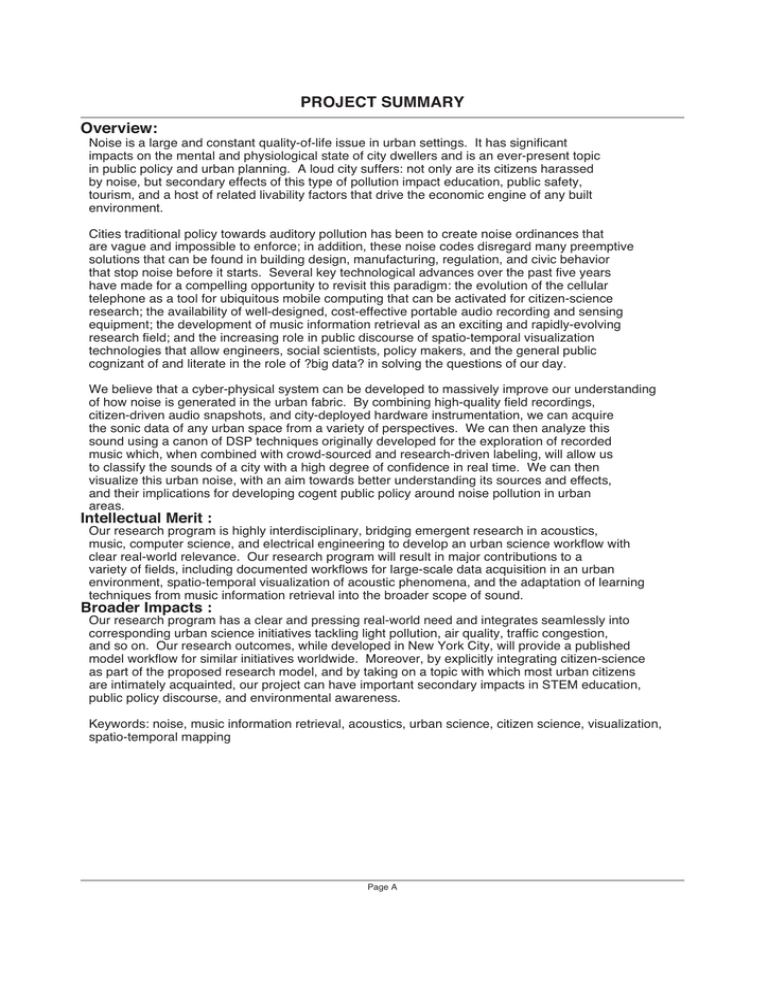PROJECT SUMMARY Overview:
advertisement

PROJECT SUMMARY Overview: Noise is a large and constant quality-of-life issue in urban settings. It has significant impacts on the mental and physiological state of city dwellers and is an ever-present topic in public policy and urban planning. A loud city suffers: not only are its citizens harassed by noise, but secondary effects of this type of pollution impact education, public safety, tourism, and a host of related livability factors that drive the economic engine of any built environment. Cities traditional policy towards auditory pollution has been to create noise ordinances that are vague and impossible to enforce; in addition, these noise codes disregard many preemptive solutions that can be found in building design, manufacturing, regulation, and civic behavior that stop noise before it starts. Several key technological advances over the past five years have made for a compelling opportunity to revisit this paradigm: the evolution of the cellular telephone as a tool for ubiquitous mobile computing that can be activated for citizen-science research; the availability of well-designed, cost-effective portable audio recording and sensing equipment; the development of music information retrieval as an exciting and rapidly-evolving research field; and the increasing role in public discourse of spatio-temporal visualization technologies that allow engineers, social scientists, policy makers, and the general public cognizant of and literate in the role of ?big data? in solving the questions of our day. We believe that a cyber-physical system can be developed to massively improve our understanding of how noise is generated in the urban fabric. By combining high-quality field recordings, citizen-driven audio snapshots, and city-deployed hardware instrumentation, we can acquire the sonic data of any urban space from a variety of perspectives. We can then analyze this sound using a canon of DSP techniques originally developed for the exploration of recorded music which, when combined with crowd-sourced and research-driven labeling, will allow us to classify the sounds of a city with a high degree of confidence in real time. We can then visualize this urban noise, with an aim towards better understanding its sources and effects, and their implications for developing cogent public policy around noise pollution in urban areas. Intellectual Merit : Our research program is highly interdisciplinary, bridging emergent research in acoustics, music, computer science, and electrical engineering to develop an urban science workflow with clear real-world relevance. Our research program will result in major contributions to a variety of fields, including documented workflows for large-scale data acquisition in an urban environment, spatio-temporal visualization of acoustic phenomena, and the adaptation of learning techniques from music information retrieval into the broader scope of sound. Broader Impacts : Our research program has a clear and pressing real-world need and integrates seamlessly into corresponding urban science initiatives tackling light pollution, air quality, traffic congestion, and so on. Our research outcomes, while developed in New York City, will provide a published model workflow for similar initiatives worldwide. Moreover, by explicitly integrating citizen-science as part of the proposed research model, and by taking on a topic with which most urban citizens are intimately acquainted, our project can have important secondary impacts in STEM education, public policy discourse, and environmental awareness. Keywords: noise, music information retrieval, acoustics, urban science, citizen science, visualization, spatio-temporal mapping Page A


